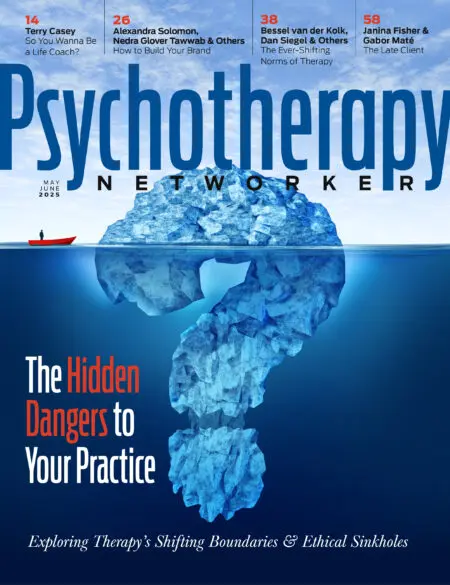When my oldest son, Cooper, was four, he largely stopped speaking, eating, and wanting to leave the house or move his body. He refused to do most activities—putting on his own socks, walking up the stairs, playing with toys, drawing pictures, even answering simple questions—and pushing him to do any of these things resulted in explosive meltdowns that regularly lasted anywhere from 30 to 60 minutes. No traditional forms of soothing or parenting helped.
On the occasions he did speak, it was often to tell us his legs weren’t working so he couldn’t walk where we were going, even a block away. Or to scream “No,” yet again, to a suggestion of something most other four-year-olds would do happily, like walk out the door to get ice cream.
We saw specialist after specialist, and in countless fields, only to be dismissed or blamed for what was happening. The blame was often paired with a reprimand to be more consistent—code for strict—in our parenting. He needs to know who’s in charge, they said. You must extinguish this behavior, they insisted. Because our son had always been challenging, this was advice we’d often heard and had already been doing our best to implement.
Like the type-A, traditional parent I once was, I followed the rules and instructions I was given. I used 1-2-3 Magic and Positive Discipline with the support of pediatricians. The former called for time-outs, and enforcing them were some of the most traumatic moments I’ve had as a mom. I remember putting our four-year-old in a bedroom, and my husband or I would try to ignore his screaming while we closed the door and held it shut while Cooper pounded on it, first with his fists, then with his writhing legs from down on the floor.
What I now know is that these were full-on panic attacks. But the experts I met with then did not. When Cooper escalated to the point where I couldn’t manage anymore, I didn’t know what to do, and it seemed no one else did either. “Next time a meltdown lasts that long,” our pediatrician said, “take him to the children’s psychiatric emergency room.”
Instead, I left my career. At the time I was leading Pew Charitable Trust’s research quality team, but because my son could no longer attend daycare, and we feared the possibility of drastic medical intervention like implanting a feeding tube, it didn’t feel like I had a choice.
Without a diagnosis or structural supports, and unable to live on only one income in Washington, DC, we moved to a small town in my home state of Michigan. The changes jarred all of us, including Cooper. A few weeks after we arrived in Michigan, he could only eat Honey Nut Cheerios, out of one specific bowl, and never with milk.
The confusion about why this was happening was no clearer in Michigan than it had been in DC. Our new environment, daycare providers, and medical team had no new suggestions. The lack of insight and understanding left us feeling utterly alone—and in many ways, we were.
Then, as we began feeding therapy for Cooper, an astute occupational therapist (who saw that the traditional strategies weren’t working) suggested I look into Pathological Demand Avoidance (PDA)—also referred to as Pervasive Drive for Autonomy. As soon as I read about it, it was like a veil lifted. I finally began to feel like I understood my son.
This was in 2020, and I spent the next two years—and the pandemic—providing around-the-clock care to Cooper. The main “accommodation” I provided was my own nervous system: giving him undivided attention. When I didn’t, I risked him exploding into a meltdown or lashing out physically at his one-year-old brother. My only reliable reprieve were screens. As my own nervous system frayed, I increasingly allowed Cooper to indulge in these distractions—but even then, he’d sometimes control my line of vision by requiring me to look at whatever he was watching with him.
What I now know is that both Cooper and I were experiencing nervous system burnout. Those were the hardest, most soul-crushing years of my life, but they also gave me the opportunity to truly understand my son’s challenges with the correct logic. And it was from there that all my decisions, creative problem-solving, ideas for accommodations, and strategies flowed.
Now, as a parent educator for thousands of families with PDA children and teens, and a researcher conducting empirical studies on PDA with the University of Michigan Medical School, I have both an intimate and a bird’s eye view of the mechanisms of PDA. I believe clearly defining PDA as a neurotype and nervous system disability will enable us all—parents, pediatricians, teachers, and therapists—to vastly improve the lives of PDA children, teens, and adults.
A Nervous System Disability
If you’re a clinician or a parent who’s taken an info-dive into PDA online or on social media, or gone deeper into the peer-reviewed research, it’s probably for a reason: there’s something familiar about stories like mine. But you might still be confused. After all, much of what’s been written about PDA focuses on whether it even exists. And when it is acknowledged, it’s often broadly defined as an “anxiety-driven need for control” or confused with other diagnoses like generalized anxiety disorder, autism, ADHD, ODD, bipolar disorder, or other personality disorders.
This is especially confusing for professionals because it suggests that CBT and exposure-based approaches would be effective treatments, when in reality, these cognitive and behavioral treatments are rarely helpful for PDAers. In fact, they often make things worse, especially when a PDA child, teen, or adult is in burnout.
A more accurate conceptualization of this unique brain-wiring is as a survival drive for autonomy and equality that consistently overrides other survival instincts—like eating, sleeping, hygiene, toileting, and maintaining physical safety toward oneself or others—either in a single moment, or as nervous system stress accumulates.
This is what happened to Cooper, and what I’ve seen play out in thousands of families. Over time, as PDAers perceive threats invisible to others, they experience acute nervous system activation that eventually disables them. The challenging behaviors we see as a result are a subconscious attempt to regain control or equalize back to nervous system safety.
Whether from a five-year-old or a 40-year-old, these “equalizing” behaviors can look like controlling, manipulating, trying to be “above” another, correcting, or acting aggressively toward a safe or “weak” person. With a more internalized expression of PDA (more freeze/fawn than fight/flight), we tend to see these behaviors aimed at the self in the form of self-harm, or the destruction of one’s own things.
Equalizing, or the need for control, often coalesces around one or more basic needs (for my son, it was eating). The physiological impact of all the accumulated stress PDAers experience often leads to medical issues like insomnia, toileting regression, encopresis, UTIs, restrictive eating, compulsive eating, and the inability to engage in physical hygiene. All this tends to get separated out from their behavior challenges.
An Autonomy Focus
Another way to think of this subconscious cycle is to imagine you’re being held up at gun point in a dark alley. Without thinking, your nervous system reacts with “fight” behavior, and you swear, hit, bite, and punch the assailant. Your adrenaline is coursing, your muscles tense, your pupils dilate into laser vision, your digestion slows, and you feel no hunger. Or maybe you “freeze” in front of the assailant, are unable to move, go mute, or even collapse, allowing the thief to take whatever they want from you.
Either way, what your nervous system did saved your life. And even though you may question it afterward—where did that violence come from in me? or why didn’t I defend myself or run?—you know you did it without choosing to do so. Your body reacted to a perceived danger and life threat.
Now imagine that this is what your nervous system perceives every time you experience a loss of autonomy, freedom, and choice. And every time another person is “above” you in stature, authority, or posture, or you’re in a situation that seems to require submission. Every day when your parent tells you to get dressed, sit up straight at breakfast, or pack your backpack, your metabolism slows, your adrenaline courses, you get tunnel vision, and you go mute. If you had these types of physiological responses day in and day out to what appear to be ordinary daily expectations, tasks, and situations, then we might expect you to lose the ability to consistently eat, go to the toilet, sleep, make your legs carry you, or even speak.
This conceptualization of PDA as a nervous system disability impacting both behavior and basic needs is what we’re conducting research on at the University of Michigan. Our first study surveyed more than 700 parents who considered their child or teen PDA and found that in addition to behavior (equalizing, dysregulation, fight/flight, and avoidance), the impacts on basic needs (sleeping, eating, hygiene, and toileting) were also statistically significant factors that can be used to develop a better measure of PDA. While this research is incipient, it’s enough to move us beyond the theoretical debate on whether or not PDA exists. It also helps us formulate a more accurate picture of the challenges of PDA. Our hope in submitting our study for peer review and publication, along with the PDA-Q (a questionnaire for identifying PDA), is that it will eventually ensure that PDA is included in a future edition of the Diagnostic and Statistical Manual, so that families don’t have to go through what I and so many of my clients have gone through to get the support they need.
Once families identify that their child or teen is PDA, and are then equipped with a clear understanding of what that means and how they can make accommodations, they make enormous gains. For example, within six months of identifying their child as PDA, many parents I’ve worked with have reported that their teen is no longer attempting suicide after previous hospitalizations and more traditional approaches failed to stop the attempts; their child has gained much needed weight (even moving from 1 percent BMI to 21 percent BMI) after all previous feeding approaches and strategies failed; their teen is leaving their room for the first time in a year and engaging with their family again; their child is asking to go to the park, after refusing to leave the house for months; their child, diagnosed with selective mutism, is using more new words and speaking more than ever.
We consistently see transformative success in treating PDA as nervous-system driven and using autonomy-focused accommodations. This is also true for families who’ve previously tried—to no avail—applied behavioral analysis, other types of behavioral conditioning, “teaching skills” or “correcting behavior.”
My own family’s experience is one of these success stories. My son, now in fourth grade, loves being back in school—a private one, where children’s autonomy is encouraged. He has strong verbal and social skills and countless friends through school and athletics, and will soon graduate from feeding therapy.
Through the PDA Lens
Although our understanding of PDA is still evolving, therapists don’t have to feel lost when it comes to working with PDAers or their parents. The skill I believe will most quickly and effectively help therapists integrate their own methods and clinical frameworks in their work with PDAers is what I call the PDA Lens.
I imagine the PDA Lens as a pair of glasses that we can put on and take off. We put them on when we want to experiment with the idea that the challenges our client (or their child or teen) face are driven by PDA. In other words, when we put the glasses on, we assume that the client’s nervous system is perceiving mortal threat at every loss of autonomy or equality. They may be able to mask this in less “safe” scenarios—at school, with grandparents, or for an adult at work—but the nervous system activation they experience in these environments builds and may eventually disable them from feeling safe and emotionally regulated enough to attune to their body’s needs.
Then, with our glasses still on, we think through how we can best support this client. How do we demonstrate compassion, patience, and flexibility for a person with a disability that’s out of their control—one they may not even understand—but that we believe (or are willing to experiment with believing) is driven by their nervous system’s need for autonomy and equality?
Each therapist will answer that question differently, depending on their professional training, creativity, and the specific circumstances and challenges the client is facing. Regardless, if the client consistently responds positively, this could be evidence that they are indeed PDA. And knowing that, and what it means, can open up a world of possibilities.
Casey Ehrlich
Casey Ehrlich, PhD, is the founder and CEO of At Peace Parents. She has helped thousands of parents better understand and support their PDA children and teens and provides a free class for therapists at www.atpeaceparents.com.













